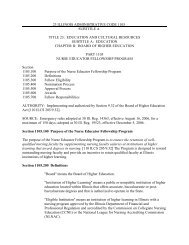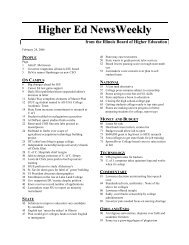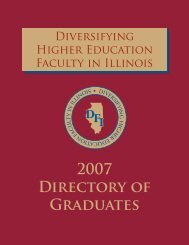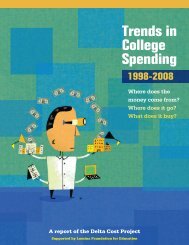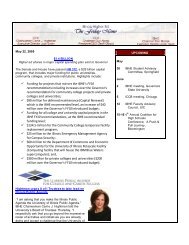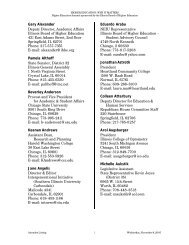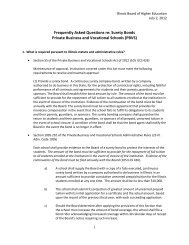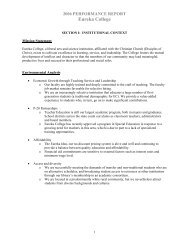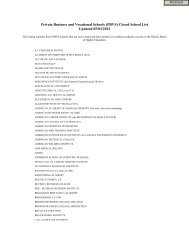A Report on the Feasibility of Textbook Rental - IBHE
A Report on the Feasibility of Textbook Rental - IBHE
A Report on the Feasibility of Textbook Rental - IBHE
You also want an ePaper? Increase the reach of your titles
YUMPU automatically turns print PDFs into web optimized ePapers that Google loves.
According to <strong>the</strong> Student M<strong>on</strong>itor, in 2006 <strong>the</strong> awareness <strong>of</strong> availability <strong>of</strong> digitalversi<strong>on</strong>s from campus bookstores and/or websites grew by 6 percent over 2005. Students whohave purchased digital textbooks from campus bookstores or <strong>on</strong>line companies have grown from4 percent in 2005 to 6 percent in 2006. Students surveyed by <strong>the</strong> Student M<strong>on</strong>itor cited <strong>the</strong>following reas<strong>on</strong>s for choosing to purchase e-books:• student likes to try new technology (43%);• e-book/digital versi<strong>on</strong> was recommended to <strong>the</strong> student (40%);• e-book was less expensive than <strong>the</strong> printed versi<strong>on</strong> (31%); and• e-book was more c<strong>on</strong>venient than <strong>the</strong> printed versi<strong>on</strong> (9%) (Student M<strong>on</strong>itor 2006).Reas<strong>on</strong>s cited by students for not using e-books include:• student preferred traditi<strong>on</strong>al printed textbooks (54%);• student preferred to purchase used textbooks (22%);• printed versi<strong>on</strong>s were more c<strong>on</strong>venient to purchase (13%);• e-book was not available (13%);• student did not own a computer (7%); and• student was unaware <strong>of</strong> e-books (7%) (Student M<strong>on</strong>itor 2006).E-books. E-books are digital textbooks that students may view electr<strong>on</strong>ically over <strong>the</strong>internet. Approximately 3,000 e-book titles are currently <strong>of</strong>fered by publishers. E-books are lesscostly because large upfr<strong>on</strong>t capital, warehousing, inventorying, and redistributi<strong>on</strong> costs are notrequired (Schroeder 2006). “In <strong>the</strong> last year <strong>the</strong> typical price <strong>of</strong> digital c<strong>on</strong>tent (academic) was 20– 30 percent below <strong>the</strong> retail price <strong>of</strong> <strong>the</strong> printed versi<strong>on</strong> (new book)” which does not includeassociated costs, such as paper and printer. “Since buyback is not an opti<strong>on</strong> for digital c<strong>on</strong>tent, <strong>the</strong>total cost <strong>of</strong> ownership is <strong>of</strong>ten <strong>the</strong> highest (most expensive) for digital” (Nati<strong>on</strong>al Associati<strong>on</strong> <strong>of</strong>College Stores resp<strong>on</strong>se to draft report 2006).The standard length <strong>of</strong> time an e-book is accessible is <strong>on</strong>e semester, though standardsvary by publisher. According to resp<strong>on</strong>ses to <strong>the</strong> <strong>IBHE</strong> survey, two community colleges and fourpublic universities <strong>of</strong>fer e-books. Ano<strong>the</strong>r community college previously <strong>of</strong>fered e-books, butended <strong>the</strong> practice due to lack <strong>of</strong> student interest (Instituti<strong>on</strong>al Resp<strong>on</strong>ses to Survey 2006). Thisalternative would have no fiscal impact <strong>on</strong> <strong>the</strong> State and little to no impact <strong>on</strong> instituti<strong>on</strong>s.Although e-books can be less costly than printed textbooks, <strong>the</strong>y have limitati<strong>on</strong>s. Forinstance, electr<strong>on</strong>ic versi<strong>on</strong>s available over <strong>the</strong> internet may have limited accessibility forindividuals with disabilities. Also, due to <strong>the</strong> large amount <strong>of</strong> data that must be downloaded,broadband c<strong>on</strong>necti<strong>on</strong>s are highly desirable. Broadband c<strong>on</strong>necti<strong>on</strong>s, however, may not beaccessible in all geographical locati<strong>on</strong>s and are usually more expensive than a dial-up c<strong>on</strong>necti<strong>on</strong>.These limitati<strong>on</strong>s could be addressed through multimedia cd-rom textbooks, which would share<strong>the</strong> producti<strong>on</strong> and materials cost advantages <strong>of</strong> internet-based e-textbooks.Freeload Press, a Minnesota publisher, <strong>of</strong>fers free e-books that include advertisements.As with all e-books, Adobe Acrobat Reader is required to download a textbook from FreeloadPress. C<strong>on</strong>sequently, <strong>the</strong> aforementi<strong>on</strong>ed limitati<strong>on</strong>s are applicable to users <strong>of</strong> Freeload Press.The following chart illustrates <strong>the</strong> cost <strong>of</strong> e-books versus <strong>the</strong> cost <strong>of</strong> printed newtextbooks, without a reducti<strong>on</strong> in cost for buy back, for a two-semester freshman load.-45-



